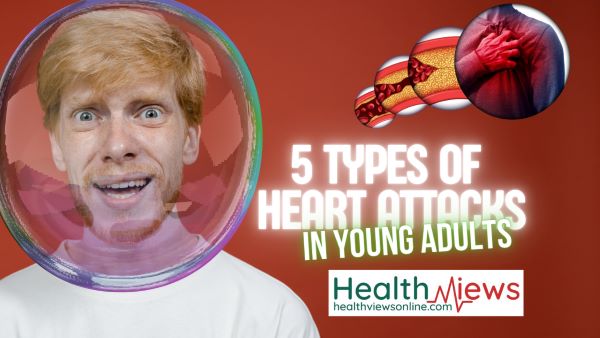Heart attacks aren’t just a problem for older folks anymore. More and more young adults—people in their 20s, 30s, and even teens—are being hit with heart-related emergencies. It’s scary, but the good news is that knowing the types of heart attacks in young adults, their causes, and warning signs can make a huge difference.
You might be thinking, “But I exercise, I eat fairly okay… I should be fine, right?” Unfortunately, lifestyle isn’t the only factor. Genetics, stress, and even seemingly harmless habits (like energy drinks and excessive work hours) play a role.
So, let’s break it down. What are the five types of heart attacks young adults need to know about?
1. STEMI (ST-Elevation Myocardial Infarction) – The Full-Blown Heart Attack
This is the big one, the kind you see in movies where someone clutches their chest and collapses. STEMI occurs when a major coronary artery is completely blocked, cutting off blood flow to the heart. If not treated fast (we’re talking minutes), the damage can be massive.
Symptoms of STEMI in Young Adults
- Intense chest pain (but sometimes, no pain at all!)
- Shortness of breath
- Nausea, dizziness
- Cold sweats
- Pain radiating to the jaw, back, or left arm
🚨 What to do? Call emergency services IMMEDIATELY. Every second counts.
Also Read: Effective Tips to Prevent Heart Attack in Winter
2. NSTEMI (Non-ST-Elevation Myocardial Infarction) – The Silent Killer
NSTEMI is tricky. It’s still a heart attack, but it doesn’t always show up on an ECG like STEMI does. The blockage is usually partial, meaning blood is still flowing—just not enough. Young people often ignore the signs because they come and go.
Common NSTEMI Symptoms
- Chest discomfort (not as crushing as STEMI)
- Fatigue (you feel drained for no reason)
- Mild shortness of breath
- A general feeling that something isn’t right
🚨 What to do? Even if the symptoms seem minor, get checked out! An untreated NSTEMI can lead to a full-blown heart attack later.
3. Coronary Artery Spasm (Prinzmetal’s Angina) – The “Random” One
Ever felt a sudden, sharp pain in your chest, but it went away quickly? That could be a coronary artery spasm. It happens when the arteries tighten suddenly, restricting blood flow—even if there’s no blockage. Stress, smoking, and even cold weather can trigger it.
Who’s at risk?
- Smokers
- People who use cocaine or other stimulants
- Those with chronic stress or anxiety
- Women (they tend to get this more than men)
🚨 What to do? If you feel this often, don’t ignore it! Medication and lifestyle changes can help prevent a more serious event.
4. MINOCA (Myocardial Infarction with Non-Obstructive Coronary Arteries) – The “Hidden” Heart Attack
Sounds strange, right? A heart attack without a blocked artery? That’s exactly what MINOCA is. It’s more common in young adults and women, and it can be caused by things like stress-related heart issues (Takotsubo cardiomyopathy), blood vessel inflammation, or even hormonal imbalances.
Signs to watch for:
- Chest pain with no obvious cause
- Abnormal heartbeats
- Feeling faint or dizzy
- Symptoms that don’t match the “classic” heart attack pattern
🚨 What to do? Demand thorough testing. Many young patients get sent home because standard tests don’t always pick this up.
5. SCAD (Spontaneous Coronary Artery Dissection) – The “Out of Nowhere” One
SCAD is as scary as it sounds. A tear suddenly forms in a coronary artery, reducing or blocking blood flow. It mostly affects young, healthy women, especially those who’ve just given birth or are under extreme stress.
Symptoms that should set off alarm bells:
- Sudden, severe chest pain
- Pain in the back or arms
- Unexplained sweating and nausea
- Shortness of breath
🚨 What to do? If you ever feel something like this—don’t brush it off. SCAD doesn’t always respond to regular heart attack treatments, so getting the right diagnosis is crucial.
Why Are Young Adults Having More Heart Attacks?
Honestly? A mix of bad habits, genetics, stress, and modern lifestyle choices. Let’s face it—we’re all glued to screens, stressed about work, skipping sleep, and consuming way too much processed food.
Some surprising heart attack triggers in young adults:
- Overworking & chronic stress – Your heart wasn’t designed to run on stress hormones 24/7.
- Lack of sleep – Just one week of poor sleep can increase heart disease risk.
- Energy drinks & excessive caffeine – These can cause irregular heartbeats and blood pressure spikes.
- Vaping & smoking – Even if it’s “just occasionally,” it damages your arteries.
- Recreational drug use (cocaine, amphetamines, etc.) – Instant heart stress, even in healthy people.
Also Read: From Smoker to Non-Smoker: A Journey of a 74-Year-Old Quitting Smoking After 52 Years
FAQs – Types of Heart Attacks – Questions Answered
1. Can a heart attack happen with no chest pain?
Yes! Especially in women and younger adults, symptoms like nausea, jaw pain, or dizziness can be the main warning signs.
2. What if I’m young and healthy—should I still worry?
Unfortunately, yes. Genetics, stress, and hidden conditions can play a role. If something feels off, get checked out.
3. Can stress alone cause a heart attack?
Absolutely. Extreme stress can trigger Takotsubo cardiomyopathy (aka “broken heart syndrome”), which mimics a heart attack. (Reference)
4. How do I know if my chest pain is serious?
If it’s new, gets worse with activity, or comes with dizziness or shortness of breath—don’t ignore it.
5. Can you survive a heart attack if you’re alone?
It’s tough, but calling emergency services immediately and coughing deeply (in some cases) might help keep oxygen flowing until help arrives.
Final Thoughts – Listen to Your Heart (Literally!)
Heart attacks aren’t just an “old person problem” anymore. The best thing you can do? Listen to your body, know your risks, and don’t wait for things to get worse. A little awareness now could save your life later.
So, what’s your take? Ever felt unexplained chest discomfort or extreme fatigue? It might be nothing… or it might be your heart sending you a signal. Don’t ignore it.





